The Peabody Memphis
Introduction
Text-to-speech Audio
The Peabody Memphis, also referred to as the “South’s Grand Hotel,” is one of the leading historic hotels in the nation. The hotel first opened in 1869 at the corner of Main and Monroe and closed in 1923 to facilitate the construction of a more modern and grander facility at The Peabody's present downtown Memphis location on Union Avenue. Built by Colonel Robert Campbell Brinkley, the hotel was named in honor of George Peabody, Brinkley's friend who passed away before the completion of the original hotel. The Peabody opened to grand acclaim in 1869, but nothing could match the opening of the 1925 Peabody Hotel with its lavish dining rooms and luxury accommodations for overnight guests. The hotel is known for the "Peabody Ducks" that live on the hotel rooftop and make daily marches through the lobby into a fountain.
Images
The Peabody Hotel in Memphis
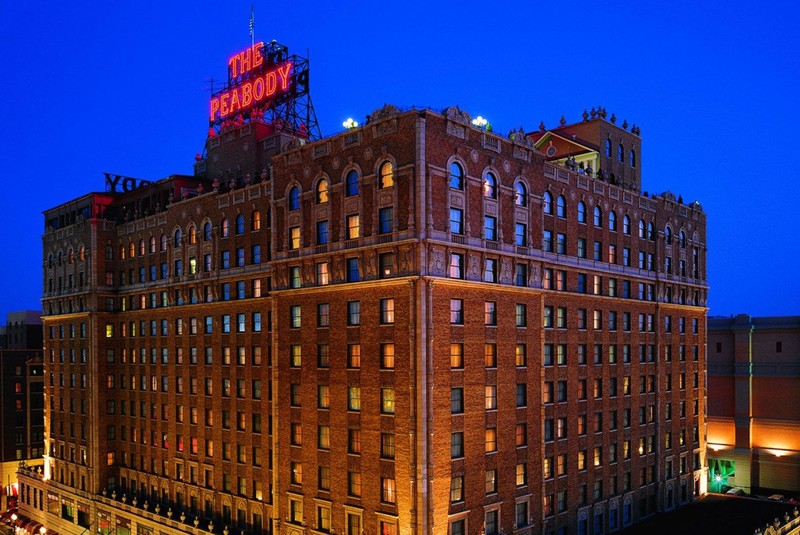
The Peabody Hotel in Memphis, 1925
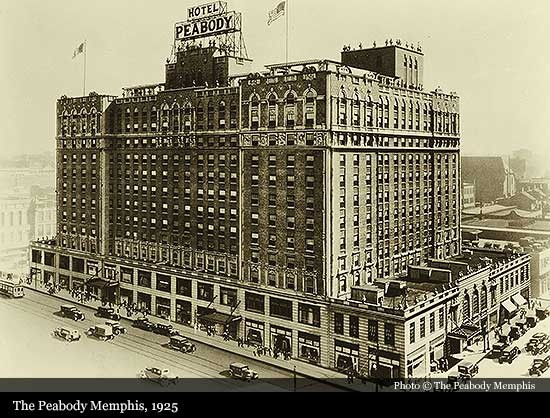
The Grand Lobby in the Peabody Hotel, 1925
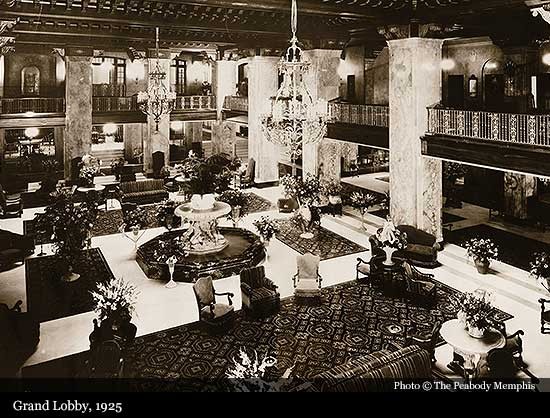
The Grand Lobby in the 2000s
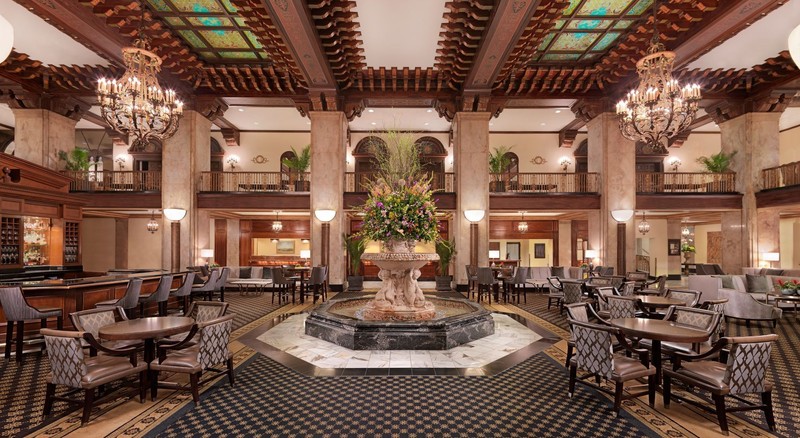
Visitors Gather to Watch the Traditional Duck March, 1968
.jpg)
The Peabody Ducks Entering the Lobby's Fountain
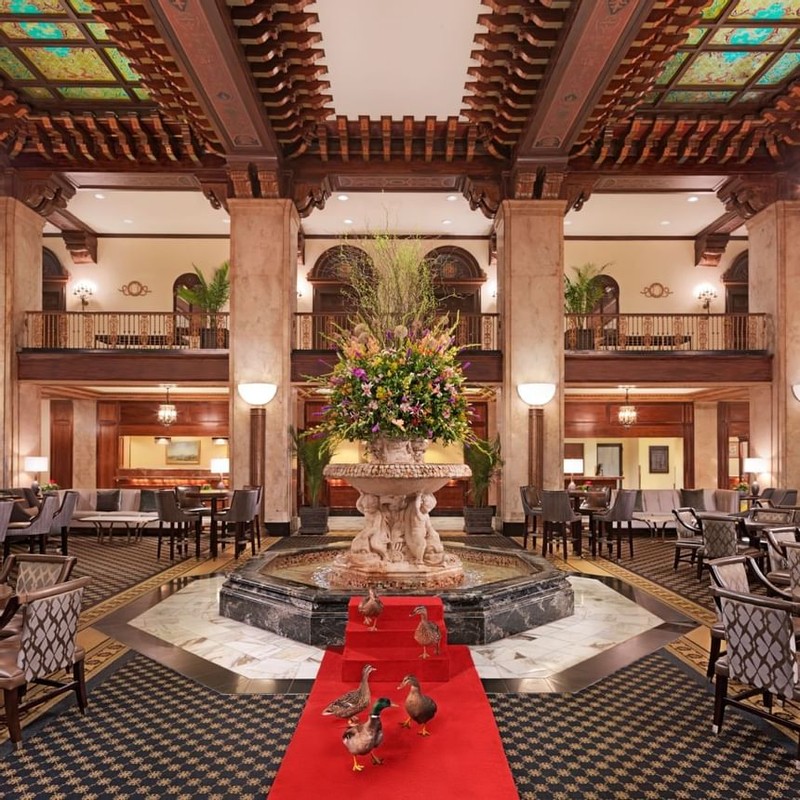
The Continental Ballroom, 1925
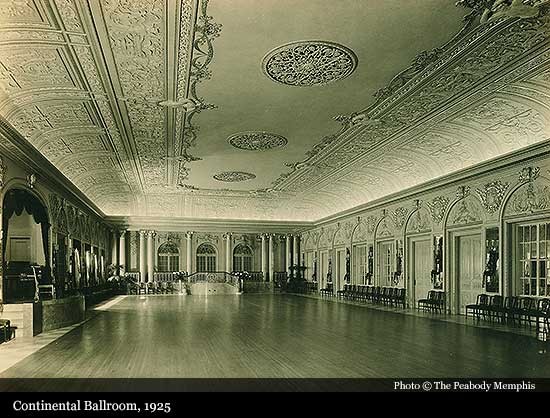
Backstory and Context
Text-to-speech Audio
The Peabody Memphis, often called the “South’s Grand Hotel,” is the finest and only historical hotel in Memphis, Tennessee. The first Peabody Hotel opened in 1869 on the corner of Main and Monroe. Constructed by Colonel Robert C. Brinkley, the original hotel consisted of thirteen stories and was composed of seventy-five luxurious rooms. That same year, Brinkley gifted the hotel to his daughter in commemoration of her wedding. Initially, Brinkley intended to name the hotel after himself, but after receiving word that his good friend, philanthropist George Peabody, had passed away, he named it in his honor.
Immediately after The Peabody opened its doors, it became a prominent social and business hub in Memphis. Known for hosting famous patrons, the first Peabody welcomed well-known names such as Confederate General Robert E. Lee and even Presidents Andrew Johnson and William McKinley. In addition, a host of Hollywood stars and plantation owners stayed at The Peabody. After surviving the “Panic of 1873,” yellow fever epidemics, a partial building collapse, fires, and a brief closure, the original hotel closed in 1923. A larger and more elaborate Peabody opened at the current location on Union Avenue in 1925. One of the key features to the new hotel was a fountain in the lobby, made from a solid block of Italian travertine marble.
In 1933, the manager of The Peabody, Frank Shutt, came back from a hunting trip in Arkansas and thought up the funny idea of leaving his live duck decoys in the hotel fountain. The guests so loved seeing these new additions in the lobby that they became permanent fixtures. The Peabody Ducks are now known worldwide. The Peabody’s “Duckmaster” marches the ducks to and from the fountain every day from their own Penthouse suite to the beat of the “King Cotton” march. The ducks conduct their daily march at 11:00 AM and 5:00 PM. Although The Peabody plays host to fine restaurants, duck is never on the menu.
Being in the heart of Memphis, The Peabody is filled with music history. Elvis Presley’s high school prom was held in the Continental Ballroom and Presley reportedly signed his first contract with Colonel Tom Parker at the hotel. In addition, much of his wardrobe was made in Lansky’s clothing store, located in the hotel. Other famous musicians who stayed at The Peabody include Jerry Lee Lewis, Johnny Cash, Carl Perkins and Neil Diamond.
In the decades that followed the new hotel’s opening, The Peabody saw renovations that included the addition of around forty shops to the downstairs lobby, including Lansky’s. As with the rest of Memphis, The Peabody saw some tough times in the late 1960s and 1970s during the Civil Rights Movement. After small fires damaged the building, it closed its doors in the mid-1970s. In 1975, Belz Enterprises purchased The Peabody and gave it new life. By 1981, the hotel had been extensively refurbished and was reopened to the public. Belz eventually launched Peabody Hotels & Resorts to further the brand’s reach and success.
The Peabody Memphis, a member of the Historic Hotels of America, remains a legendary and popular destination for all tourists and historians who pass through the monumental city. With its eclectic style, carefully preserved interior and exterior, and of course, the famous Peabody Ducks, The Peabody is truly a spectacle to behold.
Sources
Turkel, Stanley. The Peabody Memphis, Historic Hotels of America. Accessed April 17th, 2023. https://www.historichotels.org/us/hotels-resorts/the-peabody-memphis/history.php.
Learn More About One of the Most Iconic Historic Hotels in Downtown Memphis, The Peabody Memphis. Accessed April 18th, 2023. https://www.peabodymemphis.com/history.
Clark, Kym. 5 Star Stories: Secrets, skylights and celebrities of the Peabody Hotel, Action 5 News. February 25th, 2020. Accessed April 19th, 2023. https://www.actionnews5.com/2020/02/26/star-stories-secrets-skylights-celebrities-peabody-hotel/.
Peabody Hotels
Historic Hotels Then and Now
Historic Hotels Then and Now
The Peabody Memphis
Peabody Hotels
Peabody Hotels
Historic Hotels - Then and Now
